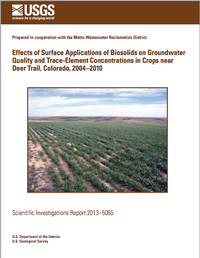The U.S. Geological Survey (USGS), in cooperation with Metro Wastewater Reclamation District (Metro District), studied biosolids composition and the effects of biosolids applications on groundwater quality and trace-element concentrations in crops of the Metro District properties near Deer Trail, Colorado, during 2004 through 2010. Priority parameters for each monitoring component included the nine trace elements regulated by Colorado for biosolids (arsenic, cadmium, copper, lead, mercury, molybdenum, nickel, selenium, and zinc); other constituents also were analyzed. All concentrations for the priority parameters in monthly biosolids samples were less than Colorado regulatory limits, and the concentrations were relatively consistent. Biosolids likely were the largest source of nitrogen and phosphorus on the Metro District properties. Plutonium isotopes were not detected in the biosolids, but many organic wastewater compounds (organic wastewater compounds: wastewater indicators, pharmaceuticals, and hormones) were detected in substantial concentrations relative to minimum reporting levels and various surface-water concentrations. Bismuth, copper, mercury, nitrogen, phosphorus, silver, biogenic sterols, detergent degradates, disinfectants, fire retardants, fragrances, pharmaceuticals, and plasticizers would be the most likely biosolids signature to indicate the presence of Metro District biosolids in soil or streambed sediment from the study area. Antimony, cadmium, cobalt, copper, molybdenum, nickel, nitrogen, phosphorus, selenium, tungsten, vanadium, zinc, detergent degradates, disinfectants, fire retardants, fragrances, pharmaceuticals or their degradates, and plasticizers would be the most likely biosolids signature for groundwater and surface water in the study area. More biosolids-signature components detected and larger concentration differences from untreated materials, baseline, and blank samples indicate more evidence of biosolids presence or effects. Although the inorganic constituent concentrations were relatively large in samples from one monitoring well, the concentrations of organic wastewater compounds in groundwater samples were not correspondingly large. Concentrations of organic wastewater compounds in the groundwater samples from all five monitoring wells were less than the minimum reporting levels with only a few detections. Some of the organic wastewater compounds detected could have anthropogenic sources that are not biosolids. Concentrations of priority parameters in groundwater varied spatially and temporally but generally were less than Colorado regulatory limits. Concentrations of dissolved nitrate, arsenic, and selenium, in addition to chloride, sulfate, total dissolved solids, boron, iron, manganese, and uranium, in samples from some wells exceeded the Colorado standards. Concentrations of dissolved nitrate (three wells), molybdenum (one well), selenium (two wells), and uranium (one well) in shallow groundwater had significant (alpha = 0.05) upward trends in some parts of the study area. The biosolids-signature results indicate that the aquifers intercepted by the five routinely sampled wells likely have received some recharge through treated (biosolids-applied) fields or biosolids-affected ponds. Adverse effects from this biosolids-related recharge range from few (if any) at one well to large and significantly (alpha = 0.05) increasing nitrate concentrations at another well. A statistical evaluation of five paired wheat-grain samples from treated (biosolids-applied) fields and untreated (control) fields did not indicate any evidence that biosolids applications significantly (alpha = 0.05 or 0.10) increased concentration of any of these constituents in wheat grain. The wheat-grain concentrations from this study were similar to those from other studies for fields in North America where no biosolids were applied. The data for the limited crop samples indicate that biosolids applications are not increasing the concentrations of arsenic, cadmium, copper, lead, mercury, molybdenum, nickel, selenium, sulfur, and zinc in mature wheat grain from the study area.


